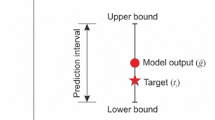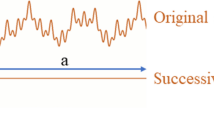Abstract
Research on the dynamics of landslide displacement forms the basis for landslide hazard prevention. This paper proposes a novel data-driven approach to monitor and predict the landslide displacement. In the first part, autoregressive moving average time series models are constructed to analyze the autocorrelation of landslide triggering factors. A linear ensemble-based extreme learning machine using the least absolute shrinkage and selection operator is applied in predicting the displacement of landslides. Five benchmarking data-driven models, the support vector machine, neural network, random forest, k-nearest neighbor, and the classical extreme learning machine, are considered as baseline models for validating the ensemble-based extreme learning machines. Numerical experiments demonstrated that the proposed prediction model produces the smallest prediction errors among all the algorithms tested. In the second part, parametric copula models are fitted on the predicted displacement, to investigate the relationship between the triggering factors and landslide displacement values. The Gumbel-Hougaard copula model performs best, which indicates strong upper tail correlation between the triggering factors and displacement values. Thresholds for the triggering factors can be obtained by monitoring the landslide moving patterns with large displacement values. The effectiveness and utility of the proposed data-driven approach have been confirmed with the landslide case study in the region of the Three Gorges Reservoir.










Similar content being viewed by others
References
Abdi M, Giveki D (2013) Automatic detection of erythemato-squamous diseases using PSO–SVM based on association rules. Eng Appl Artif Intell 26(1):603–608
Breiman L (2001) Random forests. Mach Learn 45(1):5–32
Bustos O, Yohai V (1986) Robust estimates for ARMA models. J Am Stat Assoc 81(393):155–168
Cao Y, Yin K, Alexander DE et al (2016) Using an extreme learning machine to predict the displacement of step-like landslides in relation to controlling factors. Landslides 13(Suppl 2):1–12
Chen S, Gopalakrishnan P (1998) Speaker, environment and channel change detection and clustering via the Bayesian information criterion. In: Proc. darpa broadcast news transcription and understanding workshop, vol 8. pp 127–132)
Denoeux T (1995) A k-nearest neighbor classification rule based on Dempster-Shafer theory. IEEE Transactions on Systems, Man, and Cybernetics 25(5):804–813
Du J, Yin K, Lacasse S (2013) Displacement prediction in colluvial landslides, Three Gorges Reservoir, China. Landslides 10(2):203–218
Fernández-Navarro F, Hervás-Martínez C, Sanchez-Monedero J, Gutiérrez PA (2011) MELM-GRBF: a modified version of the extreme learning machine for generalized radial basis function neural networks. Neurocomputing 74(16):2502–2510
Granger C, Newbold P (1974) Spurious regressions in econometrics. J Econ 2(2):111–120
Hao Z, AghaKouchak A (2013) Multivariate standardized drought index: a parametric multi-index model. Adv Water Resour 57:12–18
He Y, Kusiak A (2018) Performance assessment of wind turbines: data-derived quantitative metrics. IEEE Transactions on Sustainable Energy 9(1):65–73
He Y, Kusiak A, Ouyang T, Teng W (2017) Data-driven modeling of truck engine exhaust valve failures: a case study. J Mech Sci Technol 31(6):2747–2757
Huang G (2003) Learning capability and storage capacity of two-hidden-layer feedforward networks. IEEE Trans Neural Netw 14(2):274–281
Huang G, Siew C (2005) Extreme learning machine with randomly assigned RBF kernels. Int J Inf Technol 11(1):16–24
Huang G, Chen L, Siew C (2006a) Universal approximation using incremental constructive feedforward networks with random hidden nodes. IEEE Trans Neural Netw 17(4):879–892
Huang G, Zhu Q, Siew C (2006b) Extreme learning machine: theory and applications. Neurocomputing 70(1):489–501
Huang F, Huang J, Jiang S, Zhou C (2017) Landslide displacement prediction based on multivariate chaotic model and extreme learning machine. Eng Geol 218:173–186
Keefer D, Wilson R, Mark R et al (1987) Real-time landslide warning during heavy rainfall. Science 238(4829):921–925
Krkač M, Špoljarić D, Bernat S, Arbanas SM (2017) Method for prediction of landslide movements based on random forests. Landslides 14(3):947–960
LeCun Y, Boser B, Denker J et al (1990) Handwritten digit recognition with a back-propagation network. In: Advances in neural information processing systems. pp 396–404
Li X, Kong J, Wang Z (2012) Landslide displacement prediction based on combining method with optimal weight. Nat Hazards 61(2):635–646
Lian C, Zeng Z, Yao W, Tang H (2013) Displacement prediction model of landslide based on a modified ensemble empirical mode decomposition and extreme learning machine. Nat Hazards 66(2):759–771
Lian C, Zeng Z, Yao W, Tang H (2015) Multiple neural networks switched prediction for landslide displacement. Eng Geol 186:91–99
Massey C, Petley D, McSaveney M (2013) Patterns of movement in reactivated landslides. Eng Geol 159:1–19
Matsuura S, Asano S, Okamoto T (2008) Relationship between rain and/or meltwater, pore-water pressure and displacement of a reactivated landslide. Eng Geol 101(1–2):49–59
McLeod A, Li W (1983) Diagnostic checking ARMA time series models using squared-residual autocorrelations. J Time Ser Anal 4(4):269–273
Miao H, Wang G, Yin K, Kamai T, Li Y (2014) Mechanism of the slow-moving landslides in Jurassic red-strata in the Three Gorges Reservoir, China. Eng Geol 171:59–69
Miao F, Wu Y, Xie Y et al (2018) Prediction of landslide displacement with step-like behavior based on multialgorithm optimization and a support vector regression model. Landslides 15(3):475–488
Miche Y, Akusok A, Veganzones D, Björk KM, Séverin E, du Jardin P, Termenon M, Lendasse A (2015) SOM-ELM—self-organized clustering using ELM. Neurocomputing 165:238–254
Onken A, Grünewälder S, Munk M et al (2009) Analyzing short-term noise dependencies of spike-counts in macaque prefrontal cortex using copulas and the flashlight transformation. PLoS Comput Biol 5(11):e1000577
Ouammi A, Dagdougui H, Sacile R, Mimet A (2010) Monthly and seasonal assessment of wind energy characteristics at four monitored locations in Liguria region (Italy). Renew Sust Energ Rev 14(7):1959–1968
Posada D, Buckley T (2004) Model selection and model averaging in phylogenetics: advantages of Akaike information criterion and Bayesian approaches over likelihood ratio tests. Syst Biol 53(5):793–808
Reboredo J (2011) How do crude oil prices co-move?: A copula approach. Energy Econ 33(5):948–955
Sklar A (1996) Random variables, distribution functions, and copulas: a personal look backward and forward. Lecture notes-monograph series 1–14
Sun K, Huang S, Wong D et al (2017) Design and application of a variable selection method for multilayer perceptron neural network with lasso. IEEE T Neur Net Lear 28(6):1386–1396
Tibshirani R (1996) Regression shrinkage and selection via the lasso. J R Stat Soc Ser B Methodol 58:267–288
Tong S, Koller D (2001) Support vector machine active learning with applications to text classification. J Mach Learn Res 2(Nov):45–66
Tramèr F, Kurakin A, Papernot N et al (2017) Ensemble adversarial training: attacks and defenses arXiv preprint arXiv: 1705.07204
Wilcox R (2005) Kolmogorov–Smirnov test. Encyclopedia of biostatistics. https://doi.org/10.1002/0470011815.b2a15064
Xu F, Wang Y, Du J et al (2011) Study of displacement prediction model of landslide based on time series analysis. Chin J Rock Mech Eng 4:014
Yao W, Zeng Z, Lian C, Tang H (2015) Training enhanced reservoir computing predictor for landslide displacement. Eng Geol 188:101–109
Yin Y, Wang H, Gao Y, Li X (2010) Real-time monitoring and early warning of landslides at relocated Wushan Town, the Three Gorges Reservoir, China. Landslides 7(3):339–349
Yu Q, Miche Y, Eirola E, van Heeswijk M, Séverin E, Lendasse A (2013) Regularized extreme learning machine for regression with missing data. Neurocomputing 102:45–51
Zhou C, Yin K, Cao Y, Ahmed B (2016) Application of time series analysis and PSO–SVM model in predicting the Bazimen landslide in the Three Gorges Reservoir, China. Eng Geol 204:108–120
Zong W, Huang G (2011) Face recognition based on extreme learning machine. Neurocomputing 74(16):2541–2551
Acknowledgements
We are immensely grateful to the suggestions and guidance from Prof. T. W. J. van Asch from Utrecht University.
Funding
This research was supported by the Science Fund for Creative Research Groups of the National Natural Science Foundation of China (Grant No. 41521002) and the Key Program of National Natural Science Foundation of China (Grant No. 41630640).
Author information
Authors and Affiliations
Corresponding author
Rights and permissions
About this article
Cite this article
Li, H., Xu, Q., He, Y. et al. Prediction of landslide displacement with an ensemble-based extreme learning machine and copula models. Landslides 15, 2047–2059 (2018). https://doi.org/10.1007/s10346-018-1020-2
Received:
Accepted:
Published:
Issue Date:
DOI: https://doi.org/10.1007/s10346-018-1020-2




